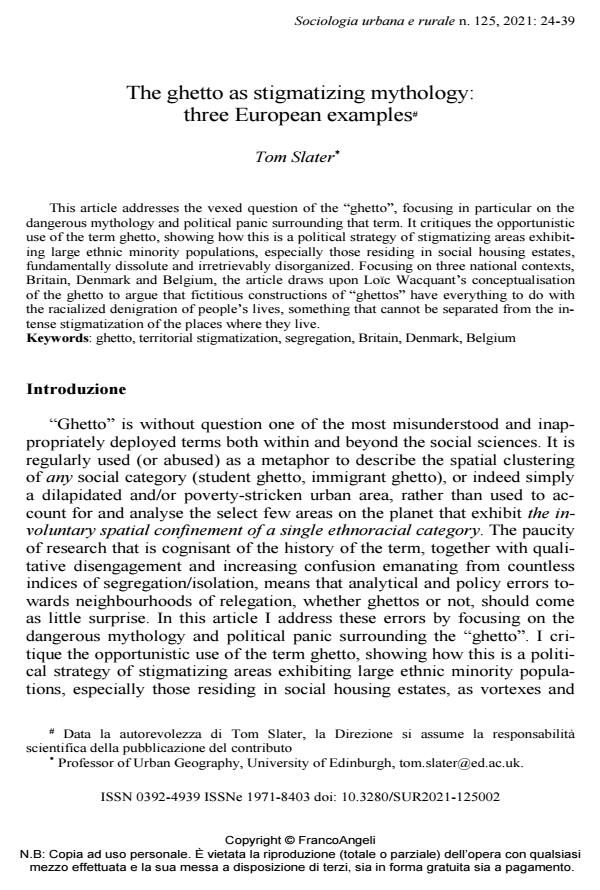The ghetto as stigmatizing mythology: three European examples
Journal title SOCIOLOGIA URBANA E RURALE
Author/s Tom Slater
Publishing Year 2021 Issue 2021/125
Language Italian Pages 16 P. 24-39 File size 302 KB
DOI 10.3280/SUR2021-125002
DOI is like a bar code for intellectual property: to have more infomation
click here
Below, you can see the article first page
If you want to buy this article in PDF format, you can do it, following the instructions to buy download credits

FrancoAngeli is member of Publishers International Linking Association, Inc (PILA), a not-for-profit association which run the CrossRef service enabling links to and from online scholarly content.
This article addresses the vexed question of the "ghetto", focusing in particular on the dangerous mythology and political panic surrounding that term. It critiques the opportunistic use of the term ghetto, showing how this is a political strategy of stigmatizing areas exhibit-ing large ethnic minority populations, especially those residing in social housing estates, fundamentally dissolute and irretrievably disorganized. Focusing on three national contexts, Britain, Denmark and Belgium, the article draws upon Loïc Wacquant’s conceptualisation of the ghetto to argue that fictitious constructions of "hettos" have everything to do with the racialized denigration of people’s lives, something that cannot be separated from the in-tense stigmatization of the places where they live.
Keywords: ghetto, territorial stigmatization, segregation, Britain, Denmark, Belgium
- Chalmers R. (2017). Is Molenbeek Really a No-Go Zone? GQ Magazine, 21st June.
- Cohen R. (2016). The Islamic State of Molenbeek. New York Times, 16th April.
- Finney N., Simpson L. (2009). Sleepwalking to Segregation: Challenging Myths About Race and Migration. Bristol: Policy Press.
- Hoffmann-Schroeder A.S. (2019). Young Women Fight the Government’s Ghetto List. Deutsche Welle (DW), 30th December. Text available here: https://www.dw.com/en/denmark-young-women-fight-the-governments-ghetto-list/a-51833223.
- Johnston R., Forrest J., Poulsen M. (2002). Are There Ethnic Enclaves/Ghettos in English Cities? Urban Studies, 39 (4): 591-618. DOI: 10.1080/00420980220119480
- Johnston R., Poulsen M., Forrest J. (2005). On the Measurement and Meaning of Residential Segregation: A Response to Simpson. Urban Studies, 42(7): 1221-1227. DOI: 10.1080/00420980500122010
- Johnston R., Poulsen M., Forrest J. (2010). Moving On From Indices, Refocusing on Mix: On Measuring and Understanding Ethnic Patterns of Residential Segregation. Journal of Ethnic and Migration Studies, 36(4): 697-706. DOI: 10.1080/13691830903505045
- Jones D. (2015). Europe’s Crucible of Terror. The Daily Mail, 16th November.
- Kundnani A. (2001). From Oldham to Bradford: the Violence of the Violated. Race and Class, 43(2): 105-31.
- Lapeyronnie D. (2007). Ghetto Urbain: Segregation, Violence, Pauvrete en France aujourd’hui. Paris: Robert Laffont.
- Peach C. (1996). Does Britain have Ghettos? Transactions of the Institute of British Geographers, 21(1): 216-235. DOI: 10.2307/622934
- Peach C. (2009). Slippery Segregation: Discovering or Manufacturing Ghettos? Journal of Ethnic and Migration Studies, 35(9): 1381-1395. DOI: 10.1080/13691830903125885
- Peach C., Byron M. (1994). Council House Sales, Residualisation and Afro-Caribbean Tenants. Journal of Social Policy, 23(3): 363-383. DOI: 10.1017/S0047279400021905
- Phillips T. (2005). After 7/7: Sleepwalking to Segregation. Speech delivered at Manchester Town Hall, 22nd September.
- Philpott T.L. (1978). The Slum and the Ghetto: Neighbourhood Deterioration and Middle-Class Reform, Chicago 1880-1930. New York: Oxford University Press. Poulsen M. (2005). The ‘New Geography’ of Ethnicity in Britain. Unpublished paper delivered to the Annual Conference of the Royal Geographical Society-Institute of British Geographers, 31st August.
- Poulsen M., Johnston R. (2006). Ethnic Residential Segregation in England: Getting the Right Message Across. Environment and Planning A, 38: 2195-2199.
- Sennett R. (1994). Flesh and Stone: The Body and the City in Western Civilization. London: Fa-ber & Faber.
- Simpson L. (2007). Ghettos of the Mind: the Empirical Behaviour of Indices of Segregation and Diversity. Journal of the Royal Statistical Society, 170(2): 405-424.
- Slater T., Anderson N. (2012). The Reputational Ghetto: Territorial Stigmatisation in St. Paul’s, Bristol. Transactions of the Institute of British Geographers, 37(4): 530-546.
- Traynor I. (2015). Molenbeek: The Brussels Borough Becoming Known as Europe’s Jihadi Cen-tral. The Guardian, 15th November.
- Wacquant L. (2004). Ghetto. In Smelser N., Baltes P. (eds.). International Encyclopedia of the Social and Behavioural Sciences. London: Pergamon Press.
- Wacquant L. (2008a). Ghettos and Anti-Ghettos: an Anatomy of the New Urban Poverty. Thesis Eleven, 94: 113-118. DOI: 10.1177/0725513608093280
- Wacquant L. (2008b). Urban Outcasts: A Comparative Sociology of Advanced Marginality. Cambridge: Polity Press.
- Wacquant L. (2010). Urban Desolation and Symbolic Denigration in the Hyperghetto. Social Psychology Quarterly, 73(3): 215-219. DOI: 10.1177/0190272510377880
- Wacquant L. (2012). A Janus-faced Institution of Ethnoracial Closure: A Sociological Specifica-tion of the Ghetto. In Hutchison R., Haynes B. (eds.). The Ghetto: Contemporary Global Is-sues and Controversies. Boulder, CA: Westview Press.
- De-stigmatizzazione territoriale e pratiche di commoning. Il caso del quartiere romano del Quarticciolo Matteo Cerasoli, Francesca Messineo, Gwon Son, in SOCIOLOGIA URBANA E RURALE 136/2025 pp.29
DOI: 10.3280/SUR2025-136004
Tom Slater, The ghetto as stigmatizing mythology: three European examples in "SOCIOLOGIA URBANA E RURALE" 125/2021, pp 24-39, DOI: 10.3280/SUR2021-125002